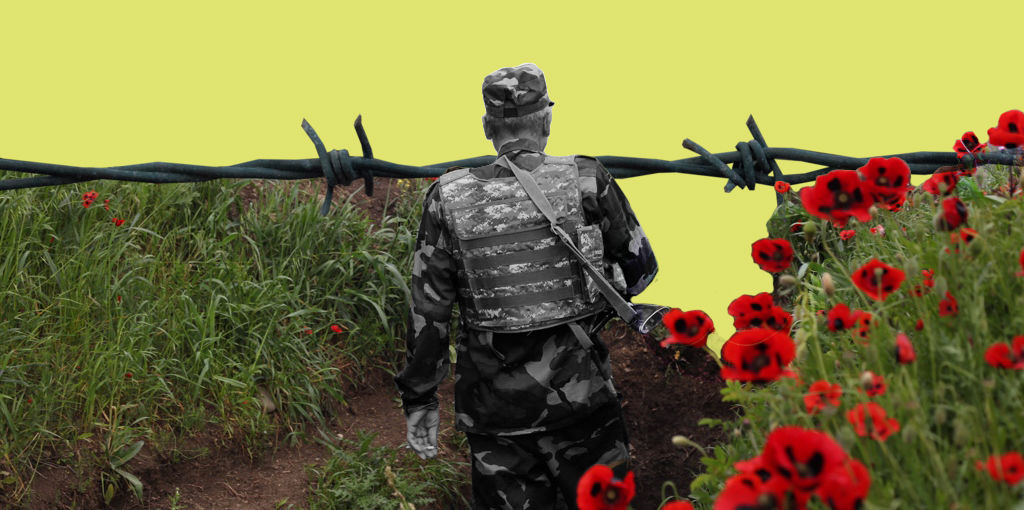
A degree of honesty, nay, uncomfortable, brute honesty is required in the broader discourse on the Karabakh conflict, and that is as follows: It is not in the interest of either side, Armenia or Azerbaijan, to resolve the conflict, considering the sacrifices that a resolution requires.
This, in essence, has become the incoherence of peace that is the Karabakh quagmire. Both sides pay lip service to the ultimate goal of seeking peace, but this is dishonest and counter-productive. And we need to be truthful about this! For both parties, peace is not the solution, it is merely a preference. Thus, when both sides speak of peace, they mean completely different things. What they are actually saying, albeit subtly, yet quite conclusively, is that they each seek a specific type of peace: Peace on their own terms. Thus, Azerbaijan wants peace, but on its own terms; and Armenia wants peace, but on its own terms. Therein lies the incoherence, because the terms and interests of the two parties are so diametrically opposed, that the minimal level of compromise required to ascertain the simplest form of peace becomes untenable. Compromise immediately becomes equated with capitulation! For this reason, Armenia continues its policy of preserving the status quo, while Azerbaijan, primarily for domestic political purposes, continues its policy of revisionism and a hybrid war of attrition.
We also have to be honest about another important point: both sides have legitimate grievances. That the Armenian side is more succinct and methodical in presenting the relative primacy of its grievances does not, in the eyes of the international community, invalidate or delimit the grievances of Azerbaijan. Azerbaijan, relying on a robust interpretation of established norms within international law, presents its argument through the framework of territorial integrity. The Armenians of Artsakh, in a similar fashion, also rely on a robust interpretation of international law, but they do so through the framework of self-determination. As such, because both territorial integrity and self-determination are equally legitimate precepts, we have no other option but to concede that the grievances of both sides are legitimate. But once we elevate the discourse, the argument at hand becomes far more nuanced: when two precepts have equal legitimacy, the one mechanism of demarcating the legitimacy of one from the other is through contextual prioritization. And herein lies the argument of the Armenian side: they do not deny the grievances of Azerbaijan’s claims of territorial integrity; rather, Armenians argue that the legitimacy of the precept of self-determination supersedes the legitimacy of territorial integrity. As such, the Armenian side is stipulating contextual prioritization.
How are the Armenians doing this? By deconstructing the concept of uti possidetis. Let’s quickly dabble in international law. Azerbaijan’s claims over the region of Nagorno-Karabakh (NK) is hinged on the precept of uti possidetis juris (“as you possess”) – a form of customary law that was utilized as the primary international legal doctrine to substantiate and legitimate the formation of the 16 states after the dissolution of the Soviet Union. Uti possidetis simply implies that whatever the borders of a political unit were at the time of the dissolution, that will be their new borders as an independent state. Thus, “as you possess.” Azerbaijan’s argument here is straightforward: NK was within its Soviet borders, and upon the dissolution of the Soviet Union and the formation of a new, independent Azerbaijan, per uti possidetis, NK remains within Azerbaijan’s borders. As such, as Azerbaijan possessed NK during the Soviet period, it also possesses it as a newly-independent state.
The Armenians of NK suggest shortcomings in the uti possidetis instrument, thus applying the doctrine of self-determination, a form of jus cogens (“compelling law”), to substantiate and legitimate their right to self-rule. This precept, at the minimum, denotes that a people have a right to self-determination if their well-being, culture, history, and security are threatened. The Armenian deconstruction of uti possidetis then, is quite nuanced. In general terms, Armenians argue that Azerbaijan did not have administrative control over NK in 1991 when it became an independent country, and as such, the logic of “as you possess” becomes problematic, because Azerbaijan did not possess any part of the territories that form the self-proclaimed Republic of Artsakh. Further, because NK Armenians exercised effective occupation, Azerbaijani claims of uti possidetis become untenable. The Azerbaijani argument, then, falls under a different precept: the notion of “internationally recognized territory.” Thus, Baku contends that because NK was internationally recognized as part of the newly-formed Republic of Azerbaijan, its claims of territorial integrity supersede the secessionist claims of the Armenians. The problem, however, is that the “international recognition” of Azerbaijan’s territorial integrity is precisely based on uti possidetis, since this is how the territorial integrity of all post-Soviet states is recognized. As such, by deconstructing uti possidetis as questionable in being applied to Azerbaijan’s claims over NK, the very foundations of using the “internationally recognized” precept also becomes questionable. Therein lies the Armenian argument: the legitimating basis of the Azerbaijani position suffers from foundational problems. And this is where the Armenians claim that the internationally recognized legal right of self-determination supersedes Azerbaijan’s questionable claim of territorial integrity. Armenians argue that self-determination, as jus cogens, clearly supersedes Azerbaijan’s questionable reliance on uti possidetis and territorial integrity.
The picture here becomes quite clear: the two concepts are uncompromisingly opposed. If Azerbaijan’s territorial integrity is prioritized, NK cannot have independence; if NK is allotted independence, then Azerbaijan’s territorial integrity is infringed. For this reason, the two sides have taken a maximalist posture: Azerbaijan will not compromise its territorial integrity, and NK Armenians will not compromise their independence.
Maximalist Posturing and the Incentive Structure
The maximalist posturing of both sides has produced a polarization effect. With Armenia on one extreme of the continuum, and Azerbaijan on the other extreme, not only do the two negotiating sides not see anything eye-to-eye, but more so, even when they do agree to sign a foundational document that provides the framework for negotiations, they end up disagreeing on every component of the document itself. The reference in this example is quite obvious: the Madrid Principles. The interpretive differences on the principles themselves, for example, is informed by the maximalist positions of both sides: it is as if the two sides are talking about two completely different documents. The magnitude of this polarization has produced another fallout: the incentive structure for compromise.
From a pure rational choice perspective, Armenia has no incentive to negotiate with the terms stipulated by Azerbaijan; that is, utilizing the logic of the victor, Armenia, as the victorious party, has consolidated its gains. The negotiation platform, then, does not offer Armenia a cogent incentive, or a valuable trade-off, in order for Armenia to relinquish some or any of its gains. More specifically, in the domain of cost-benefit analysis, status quo preservation remains the most beneficial, and as such, the most rational choice for the Armenian side. The Azerbaijani, position, of course, is just as rigid: understanding the lack of incentives on the Armenian side, Azerbaijan seeks to create an incentive structure through bellicose rhetoric, ad-hoc war of attrition, and a broader policy of regionally and economically isolating Armenia. Azerbaijan’s logic, then, presupposes that if sufficient punitive measures are implemented against Armenia, this will create an incentive for the Armenian side to offer concessions and compromise as a way of escaping such punitive measures. Thus, Azerbaijan is attempting to revise and alter the status quo through coercion.
The quagmire, then, has been not so much about Karabakh itself, but rather, the struggle between the two sides over this peace-through-coercion logic. The failure of this logic, of course, has become evident to all: as long as Armenia is able to balance and deter Azerbaijan’s attempts at coercion, the incentive structure will not produce the desired outcome. Simply put, Armenia has no reason to concede anything if it has nothing to gain. In the realm of risk-loss assessment, Armenia would actually lose more by compromising; the benefit of peace is simply not worth the cost (meeting Azerbaijan’s demands). Thus, for Armenia to truly negotiate, it must capitulate. And this, obviously, is not tenable. For Azerbaijan, their posture is the complete opposite: in the domain of risk-loss assessment, they have already lost, and as such, their maximalist posturing is designed to accommodate this: they have nothing else to lose! From this perspective, asking the loser to compromise is self-negating; while from the Armenian side, if the winner is being asked to compromise, then a worthy incentive has to be presented. The incentive structure, then, lies at the heart of this impasse.
Bellicose Rhetoric and the Need for Contextual Honesty
In what has been billed as a controversial statement, Armenian Defense Minister Davit Tonoyan, at a speech in New York, noted that the “territories for peace” model has been replaced with a new doctrine “new war, new territories.” This statement, however, revolves around two contextual considerations: 1) the 2016 April War, specifically; and 2) Armenia’s doctrine of preserving the status quo, generally. The first context stipulates that the circumstances that define the April War cannot and will not be repeated: any full scale operation by Azerbaijan will be met not only defensively, but also offensively. This clearly qualifies the “new territories” assertion of the Defense Minister. But this presupposition, of course, is entirely based on a singular condition: who initiates a “new war?” Since Azerbaijan initiated the April War, the indication here is quite clear: if Azerbaijan engages in a full-scale military offensive, the Armenian response will be the conquest of new territories. The claims of certain pundits or amateur commentators that Tonoyan’s statement is unconstructive or irredentist clearly indicates contextual ignorance on behalf of such commentators. Further, and within the broader context, Tonoyan’s assertion is also an expansion of a new doctrine on status quo preservation: any full-scale attempts by Azerbaijan to alter the status quo will be met with new territorial acquisition by Armenian forces. This general contextual premise is more consistent with a policy of deterrence: Azerbaijan’s ad-hoc, hybrid war of attrition will be tolerated as it exists in its limited scope, but anything beyond that will result in a disproportionate Armenian response. It is this insinuation of disproportionality that is, perhaps, frightening many pundits. However, disproportionality (conquest of new territories) is not being claimed in a vacuum; it is being claimed as a response to potential Azerbaijani aggression. In this sense, the Defense Minister’s statement is affirmation of the new government’s posture on the Karabakh quagmire: peace cannot be imposed on Armenia through force.
Tonoyan’s statement, which parsimoniously summarized the new government’s doctrine, was met by a sensationalist response from Azerbaijan: “We bring to the attention of the Armenian side that the Armed Forces of the Republic of Azerbaijan are among the most powerful armies in the world and are able to liberate the occupied territories of Azerbaijan in a short time.” This response, of course, does not merit serious analytical consideration; that is, no one takes this statement seriously. The claim that Azerbaijan has one of the “most powerful armies in the world” induces laughter from serious scholars, while claims of “liberating” territories from the Armenians “in a short time” borders the nonsensical. This nonsensical rhetoric on land acquisition, of course, is both for domestic consumption as well as an extension of President Ilham Aliyev’s own diatribes. His famous quip, for example, that “Irevan” is part of Azerbaijan’s “historic lands” was equally met with laughter: this was not so much policy, of course, but rather the frustrated tantrum of an autocratic man-child. And therein lies the issue at hand: frustration. Neither coercion, threat, nor hybrid war has produced the preferred outcome: hence Azerbaijan’s frustration at the incoherence of peace.
So why is bellicose rhetoric continuously used by both sides? Let’s be honest about this as well: because it works! Both societies have developed a political culture that compliments the rigid positions of their leadership. For the Armenians, compromise is capitulation; they have no reason to give an inch of land! For the Azerbaijanis, Armenians are inhumane occupiers, an inferior race of brutes that have victimized the noble Azerbaijani people. In both contexts, the bellicose rhetoric has resonated quite well with their respective publics. In the Armenian public sphere, the glorification of the war, and the historical justice equated with this victory, makes it conducive to sentiments of ultra-nationalism: “We won the war before, we will win it again.” For the Azerbaijanis, unable to formulate a narrative of military heroism, the discourse has resorted to Armenophobia and a collective assault on Armenianness. The tenability of this approach may not be sustainable, but by tapping into the grievances of the Azerbaijani population, the Aliyev regime has successfully demonized, not only the Armenian soldier, but also the Armenian as a human being. This is why there was collective chuckling from observers and scholars when the OSCE Minsk Group proposed that “concrete measures” are necessary “to prepare the populations for peace.” The genuineness of the Minsk Group cannot be denied; but the incoherence of the suggestion also cannot be denied. Why? We come back to our initial premise: neither side views peace as the ultimate end.
Incoherence of the Incoherent
Azerbaijan has sought a two-tiered, contradictory approach to resolving the Karabakh quagmire. With respect to the territorial facts on the ground and the military situation on the frontlines, it is revisionist and seeks to challenge and alter the status quo. However, and at the same time, within the diplomatic sphere and the format of the negotiations, it has done exactly the opposite: It has vehemently fought against any alterations and has staunchly sought to preserve the status quo. The new Armenian Government, of course, cognizant of this, has turned the tables against Baku. It has staunchly maintained, on its own end, the preservation of the status quo with respect to the territorial facts on the ground; however, in the diplomatic sphere and the negotiating format, it is challenging and seeking to alter the status quo by re-introducing Artsakh into the format. The revisionist-status quo dynamic, then, is being flipped on its head, much to the frustration of Azerbaijan. And if we had any illusions on how incoherent peace may be, we have now elevated the discourse to an incoherence of the incoherent.
The only way to bring coherence to the Karabakh quagmire is to change the incentive structure, which would then create a possibility of aligning some of the terms and interests of the two maximalist sides. More specifically, the grand strategy of Azerbaijan in forcefully incentivizing Armenia to compromise has failed. This strategy, overarchingly, has relied on three pillars: 1) economic isolation and strangulation of Armenia; 2) international pressure and depiction of the Republic of Armenia as illegal occupiers; and 3) ad-hoc war of attrition that has become more hybrid through time.
The objective of this grand strategy was to starve, neutralize and terrify Armenia, with the hopes of leveraging such developments as incentives for the Armenian side to capitulate. Simply put, the goal was to create such unbearable conditions that Armenia would have an incentive to compromise and accommodate Azerbaijan’s demands. The failure of this strategy, then, is indicative of the failure of the incentive structure. This breakdown of the incentive structure has reinforced the obvious: the perpetuation of the impasse. The only way to break the impasse is to completely overhaul the incentive structure: unless Azerbaijan can offer terms that mitigate Armenia’s cost-benefit analysis, Armenia has no incentive to alter the status quo. As a rational actor that is negotiating from a position of strength (especially after the Velvet Revolution), Armenia can neither be bullied nor cajoled. The way forward, then, has actually become more complicated than meets the eye. Azerbaijan has no plans of changing the incentive structure, and as such, Armenia has no incentive to make any concessions. Delusions of a settlement, it appears, need to be shelved for quite some time. Namely, we need to learn to crawl before we can proceed to walk; that is, we need to compromise on what we will be actually compromising on. Yes, the Karabakh quagmire has become tautological.

